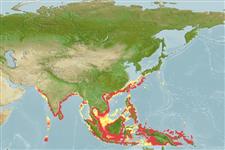Elasmobranchii (haaien en roggen) (sharks and rays) >
Orectolobiformes (Carpet sharks) >
Hemiscylliidae (Bamboo sharks)
Etymology: Chiloscyllium: cheilos (Gr.), lip, referring to membranous and broad lower lip, presumably of C. plagiosum (proposed without a species); skylion, Greek for dogfish or small shark. (See ETYFish); indicum: -icus (Gr.), belonging to: Indian Ocean, type locality. (See ETYFish).
More on author: Gmelin.
Environment: milieu / climate zone / depth range / distribution range
Ecologie
marien; zoet water; brak water demersaal; oceanodroom (Ref. 51243); diepte 0 - 90 m (Ref. 106604). Tropical; 40°N - 10°S, 65°E - 160°E
Indo-West Pacific: India, Sri Lanka, to about Bangladesh; possibly Arabian Sea, and around Thailand and Indonesia (Sumatra). Records from Solomon Islands and north to China and Japan are different species, possibly Chiloscyllium plagiosum.
Lengte bij maturiteit / Grootte / Gewicht / Leeftijd
Maturity: Lm ?, range 43 - ? cm
Max length : 65.0 cm TL mannelijk / geslacht onbekend; (Ref. 247)
Dorsale stekels (totaal) : 0; Anale stekels: 0. Genus: Nostrils subterminal on snout; pre-oral snout long, mouth closer to eyes than snout tip; eyes and supraorbital ridges hardly elevated; no black hood on head or large spot or spots on sides of body above pectoral fins (Ref. 43278). Caudal fin with a pronounced subterminal notch but without a ventral lobe (Ref. 13575).
Species: Light brown above, cream below, with numerous dark spots on body, tail, and fins, these often forming indistinct vertical bars and saddles (Ref. 31575). Dermal ridge on middle of back and two low lateral ridges (Ref. 4832).
A common, but little-known inshore sluggish bottom shark (Ref. 13575) found on sandy and muddy bottoms of coastal waters, bays and inlets and rocky and coral reefs. Probably mainly feeds on bottom-dwelling invertebrates (Ref. 13575), also small fishes. Oviparous (Ref. 50449). Utilized for human consumption (Ref. 247). Possibly may occur in fresh water in the lower reaches of the Perak River in peninsular Malaysia (Ref. 43278).
Levenscyclus en paargedrag
Maturities | Voortplanting | Spawnings | Egg(s) | Fecundities | Larven
Oviparous, deposits eggs in small, oval egg cases on the bottom (Ref. 247). Paired eggs are laid. Embryos feed solely on yolk (Ref. 50449). Distinct pairing with embrace (Ref. 205).
Compagno, L.J.V., 1984. FAO Species Catalogue. Vol. 4. Sharks of the world. An annotated and illustrated catalogue of shark species known to date. Part 1 - Hexanchiformes to Lamniformes. FAO Fish. Synop. 125(4/1):1-249. Rome, FAO. (Ref. 247)
Status op de Rode Lijst van het IUCN (Ref. 130435)
Gevaar voor de mens
Harmless
Gebruik door de mens
Visserij: commercieel
Tools
Speciale rapporten
Download XML
Internetbronnen
Estimates based on models
Preferred temperature (Ref.
123201): 25.8 - 29.3, mean 28.8 °C (based on 1477 cells).
Fylogenetische diversiteitsindex (Ref.
82804): PD
50 = 0.5039 [Uniqueness, from 0.5 = low to 2.0 = high].
Bayesian length-weight: a=0.00380 (0.00206 - 0.00702), b=3.14 (2.97 - 3.31), in cm total length, based on LWR estimates for this species & (Sub)family-body (Ref.
93245).
Trofisch niveau (Ref.
69278): 4.0 ±0.60 se; based on food items.
Weerstandsvermogen (Ref.
120179): laag, minimale populatieverdubbelingstijd 4,5-14 jaar (Fec assumed to be <100).
Fishing Vulnerability (Ref.
59153): Moderate to high vulnerability (46 of 100).
